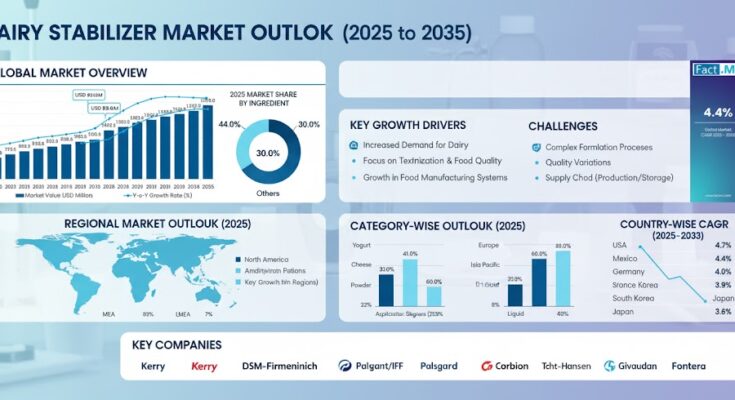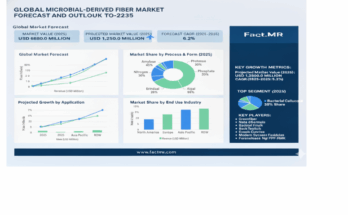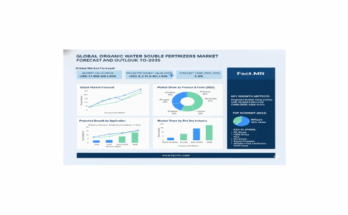The global dairy stabilizer market is witnessing sustained growth as manufacturers and food technologists emphasize texture enhancement, shelf-life improvement, and clean label formulation in dairy products. According to a recent report by Fact.MR, the market is projected to grow from USD 920.0 million in 2025 to approximately USD 1,420.0 million by 2035, recording an absolute increase of USD 500.0 million over the forecast period. This represents a compound annual growth rate (CAGR) of 4.4% between 2025 and 2035.
The market’s positive trajectory is underpinned by the growing popularity of functional and fortified dairy products, advancements in food hydrocolloids, and rising consumer preference for plant-based and low-fat formulations requiring specialized stabilization. As dairy producers expand portfolios across yogurt, cheese, ice cream, and beverages, stabilizers are playing a crucial role in ensuring consistency, taste, and texture across diverse applications.
Strategic Market Drivers
Rising Demand for Textural and Functional Dairy Products
Modern consumers increasingly seek dairy products that combine sensory appeal with nutritional benefits. Dairy stabilizers such as carrageenan, pectin, guar gum, and xanthan gum are vital in maintaining uniformity and preventing phase separation in yogurt, flavored milk, and cream products. This trend is especially prominent in premium and artisanal dairy categories.
Clean Label and Natural Ingredient Movement
The global shift toward transparency and “clean label” claims is encouraging dairy processors to adopt natural and minimally processed stabilizers. Ingredients derived from seaweed, fruit peels, or plant-based sources are gaining traction as formulators replace synthetic additives with natural alternatives to appeal to health-conscious consumers.
Technological Advancements in Food Hydrocolloids
Innovations in hydrocolloid blending and microencapsulation technologies are enabling improved performance of stabilizers under varying temperature and pH conditions. This facilitates better stability in probiotic dairy beverages, low-sugar formulations, and plant-based dairy alternatives. Manufacturers are investing in R&D to enhance multi-functionality—enabling stabilization, emulsification, and water-binding in a single ingredient solution.
Growing Dairy Production and Product Diversification
Rising global milk output, coupled with expanding product portfolios—from high-protein Greek yogurt to low-fat ice creams—continues to fuel demand for stabilizers. The trend toward value-added dairy products in developing markets further enhances opportunities for ingredient suppliers to offer tailored stabilizer blends.
Regional Growth Highlights
Europe: The Innovation Leader
Europe remains at the forefront of the dairy stabilizer market, driven by a strong dairy culture, high per-capita consumption, and early adoption of natural ingredient systems. Countries such as Germany, France, and the Netherlands are key innovation hubs, with producers focusing on clean label stabilizer systems for organic and low-fat dairy segments.
North America: Expanding Functional Dairy and Plant-based Applications
In the U.S. and Canada, rising consumption of protein-enriched and lactose-free products is propelling stabilizer adoption. Manufacturers are increasingly formulating hybrid dairy and plant-based offerings, such as oat-milk yogurts and fortified dairy beverages, where stabilizers are essential for maintaining consistency and mouthfeel.
East Asia: A High-Growth Opportunity
East Asia represents one of the fastest-growing regions, supported by rapid urbanization, growing dairy consumption in China and South Korea, and the expansion of ready-to-drink milk beverages. Local ingredient manufacturers are collaborating with global players to develop cost-effective stabilizer systems suited to regional taste profiles.
Emerging Markets: Latin America and South Asia
Emerging markets are witnessing accelerating dairy sector investments, driven by improving cold chain infrastructure and higher consumer incomes. Dairy stabilizers are in growing demand for yogurt drinks, flavored milk, and cheese spreads—especially among middle-income consumers seeking premium quality and longer shelf life.
Market Segmentation Insights
By Product Type
- Hydrocolloids (Carrageenan, Pectin, Guar Gum, Xanthan Gum): Account for the majority of stabilizer use due to their superior water-binding and emulsifying capabilities.
- Emulsifiers and Blends: Rising demand in ice cream, cheese, and dairy desserts for improved aeration and creaminess.
By Application
- Yogurt and Cultured Dairy: Largest segment, as stabilizers improve thickness, prevent whey separation, and enhance texture.
- Ice Cream and Frozen Desserts: Demand driven by texture enhancement and prevention of ice crystal formation.
- Dairy Beverages and Flavored Milk: Increasing consumption of on-the-go and fortified beverages supports the need for stabilizer systems that prevent sedimentation.
Challenges and Market Considerations
Despite promising growth, the dairy stabilizer market faces several challenges:
- Volatile Raw Material Costs: Prices of natural hydrocolloids fluctuate due to crop yield variations and supply chain disruptions.
- Regulatory Scrutiny: Growing focus on food labeling standards requires strict compliance and transparency from suppliers.
- Rise of Plant-based Dairy Alternatives: Although a potential challenge, this trend also opens opportunities for specialized stabilizer systems catering to non-dairy matrices.
- Formulation Complexity: Balancing stability with naturalness and sensory appeal remains a key R&D challenge for manufacturers.
Competitive Landscape
The dairy stabilizer market is moderately consolidated, with key players focusing on strategic partnerships, ingredient innovation, and sustainable sourcing practices. Companies are increasingly developing tailor-made stabilizer systems to address specific formulation challenges in regional dairy markets.
Key Players in the Dairy Stabilizer Market:
- Kerry Group
- DSM-Firmenich
- DuPont (now part of IFF)
- Palsgaard
- Tate & Lyle
- Corbion
- Chr. Hansen
- Givaudan
- Fonterra
- Caldic
These companies emphasize developing multi-functional, clean-label stabilizer systems while pursuing sustainability through responsible sourcing and production. Collaborative R&D initiatives and portfolio diversification across dairy and plant-based categories are defining the next phase of market evolution.
Conclusion
The global dairy stabilizer market is on a steady growth path, supported by the convergence of consumer wellness trends, dairy innovation, and food science advancements. As clean-label expectations and functional dairy demand intensify, stabilizer manufacturers are poised to play a pivotal role in shaping the future of texture, taste, and quality in dairy applications worldwide.



